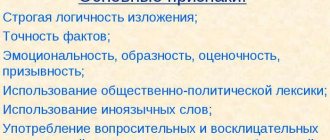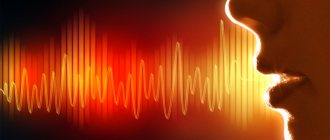Genres of journalistic style of speech are certain compositional and stylistic types of works inherent in the media.
There are three main substyles in the journalistic style:
- Informational;
- Analytical;
- Artistic and journalistic.
Each of them has its own structure, tasks and features.
Information genres of journalistic speech style
The information genre of journalism includes interviews, reports, short notes, annotations for publications, some mini-stories, etc.
This genre is used to inform the public about an event, to report something or someone.
Most often, publicists use notes in the form of short messages about interesting events and accomplished facts. In their notes, they report news or express assumptions on certain issues.
An example of a note as one of the genres of journalistic style of speech is the following text:
“Yesterday, an ambulance suddenly rushed by on a nearby street. Everything suggests that the coronavirus holiday has begun on our street.”
An example of a book summary:
“The book tells the complex story of an old man who goes in search of his old friend.”
Mini-story example:
“It happened in the attic of an old house. The children climbed onto the roof and made their way into the attic, littered with old things. Among the old rags they found one strange object that vaguely resembled a jug. Based on the outlines on its wall, one could determine the date of its manufacture—the middle of the last century.”
The most interesting genre of journalistic style can be called reportage . This is a story about a significant past event. Usually the public follows reports on interesting topics and then actively discusses them among like-minded people.
An example of a report could be the following text:
“As we all remember, the research began in a laboratory in a neighboring urban district. A dependence was identified on the level of infection spread by airborne droplets. Today this version has been refuted. We want to talk about what conclusions scientists have reached so far.”
Interviews are another interesting genre of journalistic style. Journalists use interviews to bring to the reader’s attention the opinion of some authority about a particular fact, event, incident or one’s own biography.
The interview necessarily contains questions and short answers. The answers are given in a form that the reader can understand, in simple text.
Example of a short interview:
“Do you think these difficult times will end soon? - Yes, I think that we are already on the threshold of new changes. Everything that happens around already testifies to this.”
The note
The most important of the informational newspaper genres of journalism is the note. Its function is to quickly and efficiently convey information about an event to the reader. It does not imply any thoughts of the author, or expression of his own opinion. It is important to convey information promptly and objectively.
Another distinctive feature of this genre is its small volume, it is no more than 2 thousand characters. The structure of the note is usually subject to answers to the main questions: what, where and when happened. The author of the note is not interested in the causes and consequences of the event he is talking about.
Analytical genres of journalistic speech style
Analytical texts influence a person. This is an analysis by a journalist of any fact, event, phenomenon or person.
Analytical genres include articles, conversations, reviews, and correspondence.
Like an interview, a conversation is conducted between two (sometimes more) people.
There are differences between a conversation and an interview:
Interview
The person asking the questions does not express his assumptions or conclusions regarding the issue under discussion.
A journalist has the right not to study the topic on which he will ask questions, only to compile a list of them.
The article after the interview contains a clear opinion of the interviewee.
Conversation Both partners have equal rights and can both ask and answer questions.
The journalist must be aware of the topic of the conversation, for the discussion to be interesting, both participants must be at least partially competent in the issue.
In the text presented, the issue is discussed in full and contains the opinions of each participant. And the reader can already draw certain conclusions on the problem raised during the conversation.
An article as an analytical genre of journalistic style of speech contains a detailed overview of an event, situation or fact. The author explores different sources of information, reveals his point of view on the problem and challenges the reader to think about the topic.
The following forms of articles in the analytical genre of journalism differ:
- general research - a number of issues are analyzed, for example, the economic direction of the country, the moral development of members of society, etc. The article must have a clear line between the permitted text and one’s personal views, which should not be reflected in any way. The author, as a rule, expresses the opinion of the one who analyzes the information, without adding anything of his own;
- practical-analytical - ordinary everyday problems are described, for example, in some industrial sector, and recommendations for eliminating the problem are also given;
- polemical - the text is permeated with specific polemics on the proposed topic. Different views are reviewed, as a rule: the views of scientists, politicians, psychologists, etc. Such a text is written by a specialist authorized to present reliable and verified information. It is not allowed to change the meaning of words and distort facts to suit your own opinion. The author of the article is obliged to present the material in correct literary language.
Correspondence , like reportage, tells and interprets an event. It explains the reasons for what happened and analyzes the fact, assesses its significance, and predicts further development.
But while several facts can be presented in a report, correspondence is based on only one. The entire argument is built around this one fact. The rest of the information only complements and confirms the main statement.
A review is a detailed overview of, for example, a book. The reviewer expresses his opinion about the work in such a way that the reader, even if he does not have the information, understands what the book, film or program is about.
Recently, reviews have become ironic. But this is unacceptable and only speaks of the author’s lack of professionalism.
The review must be written correctly and maintain a neutral assessment, so that every reader has an objective opinion about the work.
Definition of the concept
Before we understand what an article is, let’s figure out what the term “genre” itself means in journalism.
Genre can be called types of journalistic work that are related by similar substantive and formal characteristics.
Despite the established genre system, changes quite often occur in journalism associated with the emergence of new genres at critical times for society.
The article is distinguished by a deep analysis of facts
Also, two or more genres can merge into something new, fresh and interesting for the reader.
This becomes one of the significant reasons for such changes - the desire of journalists to convey information in a new way, to look at situations from a different perspective.
Reflection of reality, description of a social problem relevant in a given period of time, argumentation of social phenomena, competent factualization and a detailed concept of its presentation to the reader - all this fully characterizes the article as a genre of journalism.
An article is distinguished from other forms of presentation of information by a deep analysis of facts, a detailed study and disclosure of the problem, theoretical generality, the breadth of the conclusions drawn, as well as the depth of coverage of reality.
The article has a clear logical sequence with a simple and understandable composition:
- Introduction/beginning is the formulation of the problem. The introduction may describe one specific situation, event, or several for visual comparison. This could be a declaration, that is, a statement of the problem, which will contain the author’s promise to confirm his theses and arguments. The introduction can also be in the form of direct/indirect quotation.
- Thesis. Here the author designates and directs the flow of reasoning on the topic at hand. A thesis is a statement of a problem that the author will subsequently have to argue for.
- Argumentation, that is, confirmation of the author's thoughts and reasoning with specific facts, as well as links to expert opinions on the topic raised for a more complete disclosure of the problem.
- An ending in which the author formulates certain conclusions. They may not be included in the main article at the discretion of the author.
Or the author introduces a controversial opinion, which can be a good replacement for the conclusion.
Artistic and journalistic genres of journalistic style of speech
The most complex of the genres mentioned above is considered to be artistic and journalistic. After all, a journalistic text must be given an artistic coloring. This could be: a parody, an essay, a feuilleton, a pamphlet, etc.
A parody is a portrayal of someone with a hint of satire. Famous personalities whom everyone knows are often parodied. Therefore, they can easily recognize the person being parodied through a humorous performance. Parodies can both make the reader laugh and cause indignation due to ridicule and exaggeration of someone's negative personality traits.
The essay covers the event with its artistic design. A good example of an essay is a problem essay - it talks about a specific problem, and also a portrait essay - it describes an event, phenomenon, person, etc.
A feuilleton is a completely satirical text of a journalistic style of speech. Feuilletons ridicule specific problems and phenomena in the social environment.
The feuilleton gains popularity thanks to its well-written text, which does not contain rudeness or ridicule.
A pamphlet is very similar to a feuilleton, but it makes fun of a specific person, even if it is a real person.
In this genre, it is difficult not to cross the line in order not to present the hero in an offensive manner.
In future articles, I plan to explore each genre in detail with good examples.
That's all for today. This information is enough for introductory reading or preparation for an exam on the topic “Genres of journalistic style of speech.”
General signs
The explanatory dictionary of S. I. Ozhegov gives the following definition:
An article is a small scientific or journalistic composition. Newspaper, magazine village. Critical s.
In a later source - the explanatory dictionary of T.F. Efremova - a popular science genre is added to everything else.
Nowadays it is also possible to highlight an advertising article. Popular web publications have their own characteristics, which we will talk about a little later, but in general they duplicate the established system of genres.
Let’s make a reservation right away that we are talking about copyrighted articles, that is, articles written primarily by one person (not counting edits). (In contrast to them, there are collective ones, most often used in science (when creating reference books, dictionaries, encyclopedias)). Material created by one author largely retains its target, thematic and stylistic unity. This is what makes him interesting.
The purpose of the article is to bring to the reader’s consciousness certain facts, provisions, judgments or someone’s opinion about them.
Target settings set the following characteristics:
- small size;
- usually one subject of study;
- informational, explanatory, analytical or critical;
- reasoning as the defining type of text;
- objectification of the narrative (can be deliberately violated in advertising or a blog).
These are the most common features. Each genre of article has its own characteristic features.
Feature article
The artistic and journalistic genre of newspaper texts includes the essay. This is a very variable and common form. Its task is not only to tell readers about the event, but also to reveal its social significance. This genre is closer to tests of fiction.
Essays must have plots, characters, the author talks about the event in an artistic form and reveals its characteristics through the created images. There are many types of essays: portrait, problem, travel. It is not in vain that people often talk about essay literature, and there is even such a specialization - essayist, in which many outstanding writers worked: K. Paustovsky, M. Prishvin, E. Hemingway.
Reportage
The next information newspaper genre is reportage. It is also extremely popular because it allows you to obtain information from an eyewitness to an event. There is even a separate specialization in journalism: a reporter is a person who deals only with creating reportage materials. The hallmarks of the reporting genre are its relevance and efficiency.
No one is interested in reading a report about events of long ago, at least in a newspaper. The reporter must create dynamic and interesting material; he can express his opinion about the event, talk about his feelings and impressions. After all, the main task of reporting is to create the effect of presence in the reader.
Report
And the last information newspaper genre is the report. This is usually a large, detailed material telling about the progress of some event: a congress, a marathon, a conference. It may include elements of reporting and interviews. The purpose of the report is to tell objectively and quickly about how the event took place. A journalist must maintain objectivity and not express his opinion on what is happening. There are several types of reports: analytical, thematic, direct information. The first two allow the journalist to express his point of view to a limited extent.
Editorial
Separately, theorists distinguish such a genre as the editorial. It is intended to express the opinion of the editors and founder. That is why in Soviet times, editorials were always filled with ideological information. The peculiarity of this article is that it is necessarily located on the front page of the newspaper. This emphasizes the importance and relevance of the material. In such publications there cannot be a personal opinion of the author; it is always an impersonal, collective position. The most pressing events of the day are always the reason for writing editorials.







